Unit 4 Public transport Reading(1):The first underground in the world 课件(27张PPT)
文档属性
| 名称 | Unit 4 Public transport Reading(1):The first underground in the world 课件(27张PPT) |  | |
| 格式 | zip | ||
| 文件大小 | 1.1MB | ||
| 资源类型 | 教案 | ||
| 版本资源 | 牛津译林版 | ||
| 科目 | 英语 | ||
| 更新时间 | 2020-02-28 20:53:46 | ||
图片预览

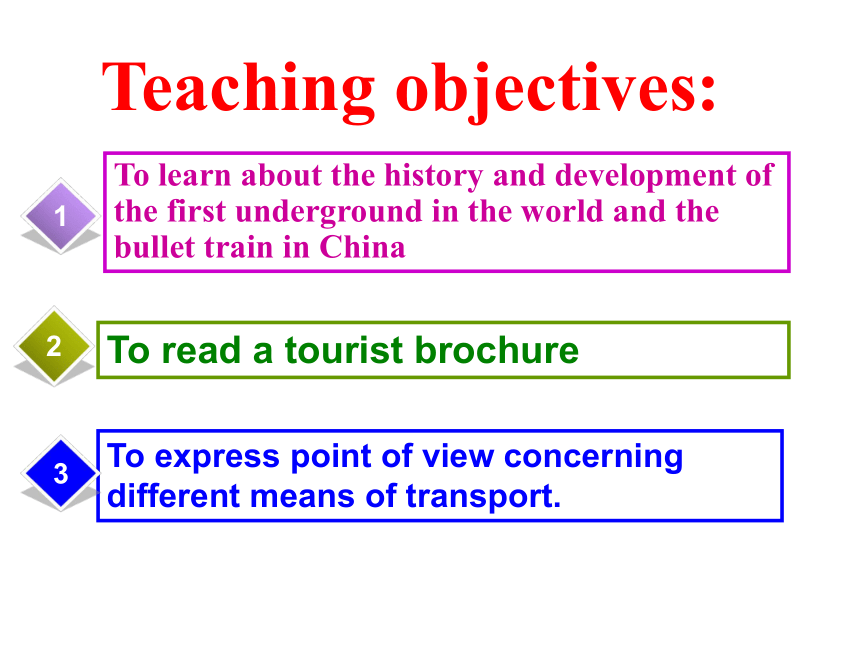
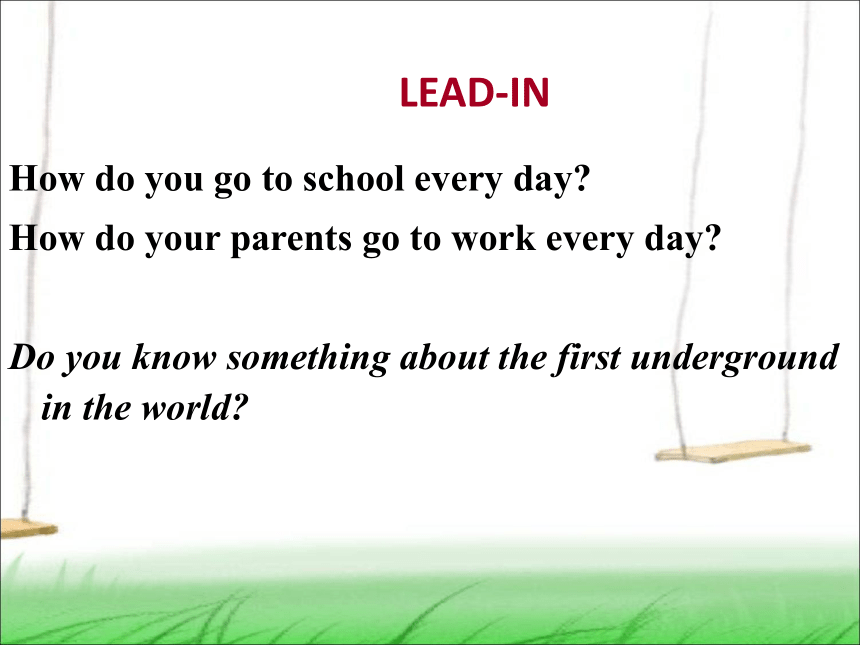
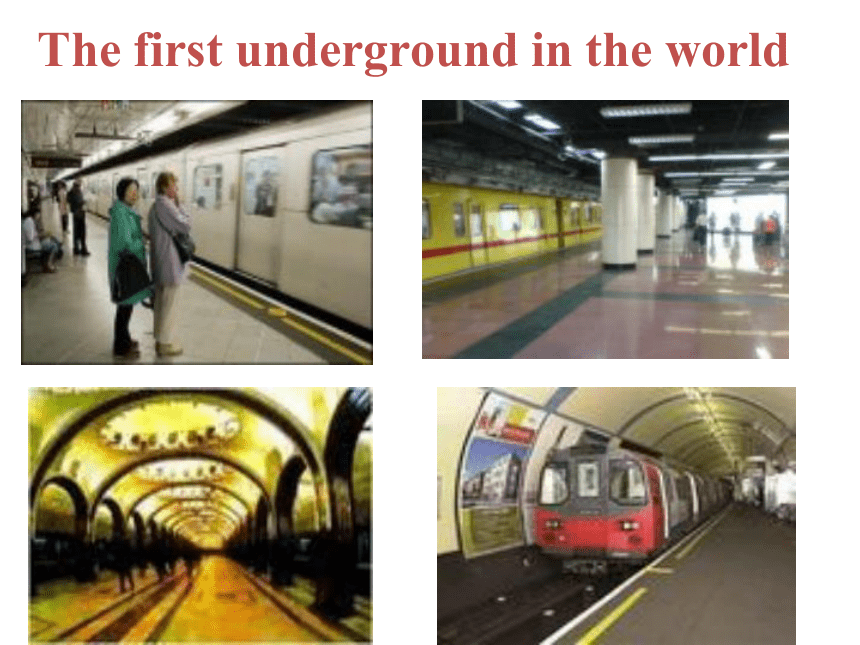
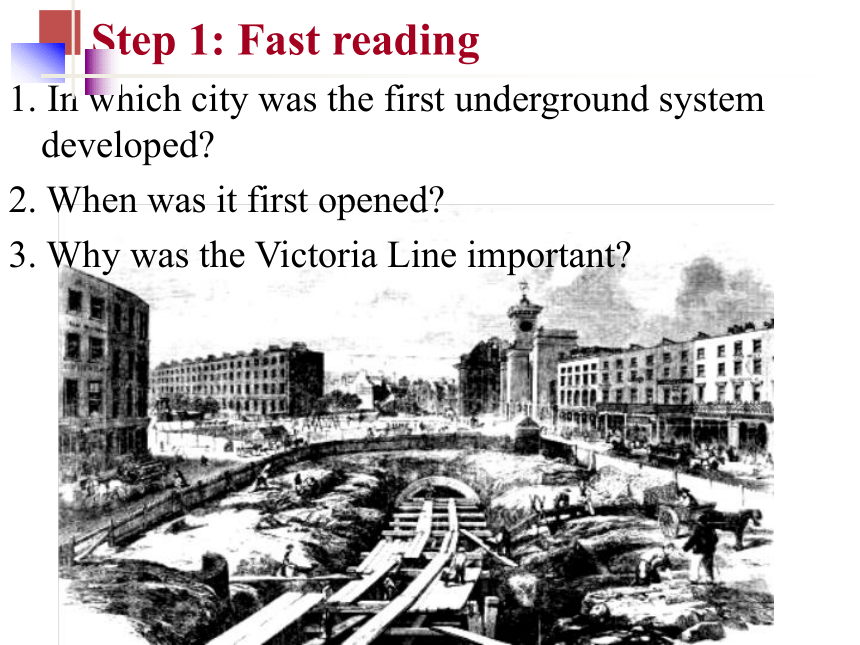
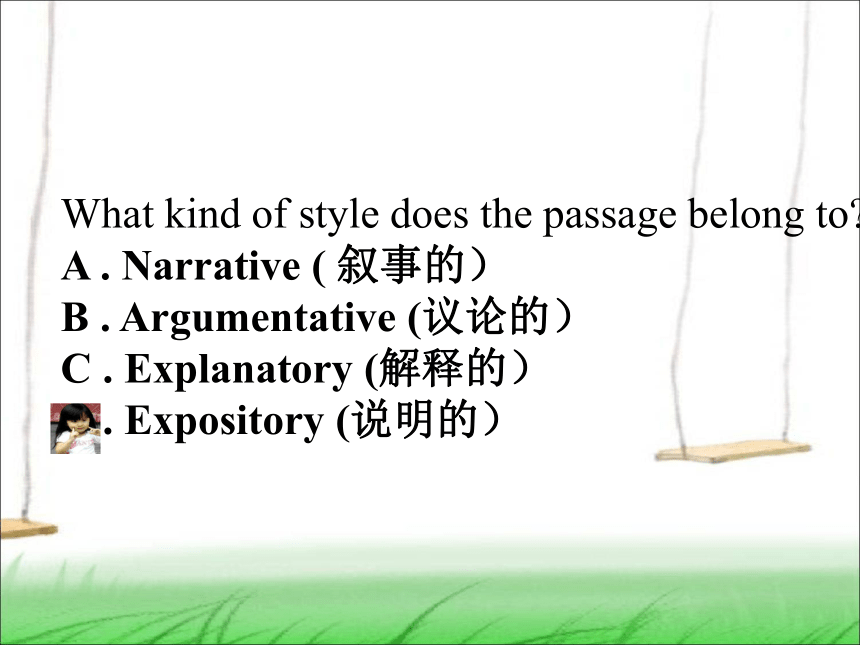
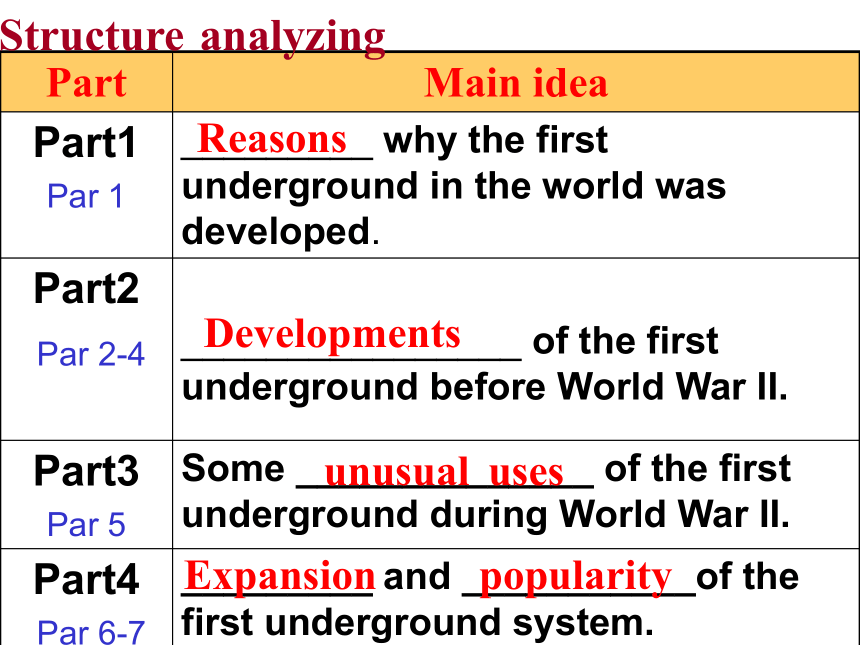
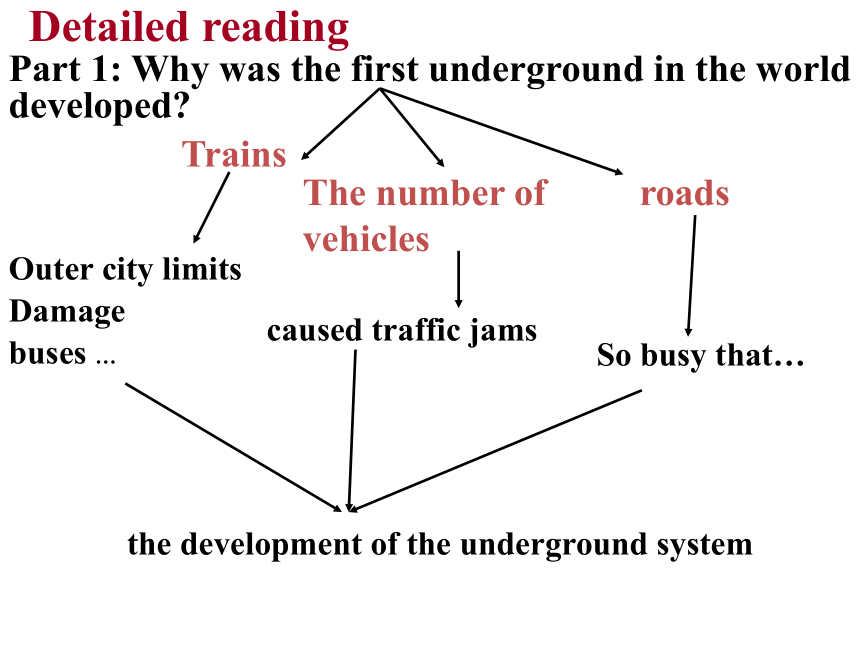

文档简介
(共27张PPT)
Module 7 Unit 4 Public transport
The first underground in the world
Reading I
To learn about the history and development of the first underground in the world and the bullet train in China
To read a tourist brochure
To express point of view concerning different means of transport.
1
2
3
Teaching objectives:
LEAD-IN
How do you go to school every day?
How do your parents go to work every day?
Do you know something about the first underground in the world?
The first underground in the world
Step 1: Fast reading
1. In which city was the first underground system developed?
2. When was it first opened?
3. Why was the Victoria Line important?
What kind of style does the passage belong to?
A . Narrative ( 叙事的)
B . Argumentative (议论的)
C . Explanatory (解释的)
D . Expository (说明的)
Reasons
Developments
unusual uses
Expansion
popularity
Structure analyzing
Part Main idea
Part1
Par 1 _________ why the first underground in the world was developed.
Part2
Par 2-4
________________ of the first underground before World War II.
Part3
Par 5 Some ______________ of the first underground during World War II.
Part4
Par 6-7
_________ and ___________of the first underground system.
Part 1: Why was the first underground in the world developed?
Trains
The number of vehicles
roads
Outer city limits
Damage
buses …
caused traffic jams
So busy that…
Detailed reading
the development of the underground system
A tourist brochure about a place of interest
A brief_______
of its development
dates or years in chronological_____
important________ who influenced or contributed to the development
Interesting ____
Sentences that_________ you to visit the place for yourself
history
order
people
facts
encourage
Reading strategy
Detailed reading Part2-4
Read the passage , and find detailed information under the 4 categories.
1. The history of its development
2. important people who influenced or contributed to the development
3. interesting facts
4. sentences that encourage you to visit the place for yourself
Detailed reading: the history of its development
An important war is used to mark the different periods of its development
Before the war:
Match the dates with the events
1854
1863
1868
1884
1933
1918-1938
An underground railway was approved to be constructed.
The initial tunnels were opened.
The next section of the underground system was opened.
The first railway tunnel under the River Thames was dug.
Many new stations were constructed.
A public organization was created.
During the war:
some _______uses of the underground
Victoria Line
last
Jubilee Line
Over Three million
twelve
After the war:
unusual
In 1945, more lines were added, which included the ____________.
In 1979 the ______ line added was the _______________.
Recent years __________________ people travel on the underground every day.
The network of the underground system includes _________ lines now.
Who are mentioned in the text and what is their contribution?
Charles Yerkes- undertook…
Charles Holden- designed…
Detailed reading: important people who influenced or contributed to the development
Some unusual uses of the underground system during the World War II
functioned as
bomb shelters
an underground airplane factory
centre for directing
the defence
meeting rooms
Detailed reading: interesting facts
In fact, it is like an advertisement.
Similar expressions:
Why don’t you…?
How about…?
You’d better…
…
“Why not take a trip on…?”
Detailed reading: sentences that encourage you to visit the place for yourself
Fill in the blanks of the extensive reading material to know
about the history and development of China’s Bullet train.
The Qinhuangdao-Shenyang passenger dedicated line, constructed in August 1. ________ and opened to traffic in October 2. ________ ….In 3. ________, the Chinese government approved the Mid and Long-term Railway network Program….In August 4. ________, the first high speed railway in China, Beijing-Tianjin intercity railway ….opened to traffic. In June 5. ________, the Beijing-Shanghai high speed railway entered service….. In December 6. ________, the Harbin-Dalian high speed railway, …opened to traffic. … It is expected that by the end of 7. ________, total mileage of high speed railways in China will reach 19000 km. By 8. ________, an express passenger railway network….will reach more than 50000 km, basically covering all cities with a population of more than 500000.
Extensive reading: To know about public transport in China
airplane
helicopter
ship ferry
motorboat
light railway, bicycle, underground, taxi, railway, motorbike, train, car, minibus,
bus, coach…
Brainstorming: Do you know other modes of transport?
distance time
cost comfort
safety/security insurance
convenience weather
service speed…
Critical thinking: Discussion
What factors do you have to consider before choosing a
means of transport?
Creative thinking: Reading-based writing
What kind of transportation would you choose if you want to travel to a place 40 miles away from your home and why?
My favorite means
of transport
If I need to travel to a place 40 miles away from my home, I would choose…
Creative thinking: Reading-based writing
Items
Is the handwriting neat?
2. Do you have a topic sentence?
3. Do you state your reasons clearly?
4. Is the passage well organized?
5. Do you include your recommendations?
My version
If I need to travel to a place 40 miles away from my home, I would choose the comfortable, safe, reliable and fast high speed railways. Firstly, high speed railway saves time cost and logistic cost and drives the sustainable growth of railway traffic. Secondly, the development of high speed railways has promoted the industrialization and urbanization process. The time and space gap between regions and cities are filled and service scope of the railway covers more widely. Thirdly, opening of high speed railways also has promoted the tourism, catering, trade and service industries along the railway and in vicinity areas, created job opportunities and become an impetus boosting development of the tertiary industry. Thus, the high speed railway is my favorite means of transport. Why not try it someday?
Stay away from aggressive road users
Avoid absence of mind, alcoholic drinks
and speeding
Follow traffic rules and instructions of the
police
Ensure the good condition of the vehicles
S
A
F
E
Acronym: SAFE
HOMEWORK
1. Polish up your passage.
2. Finish Part D and E on page 52 and 53.
Thank you
for your attention!
Module 7 Unit 4 Public transport
The first underground in the world
Reading I
To learn about the history and development of the first underground in the world and the bullet train in China
To read a tourist brochure
To express point of view concerning different means of transport.
1
2
3
Teaching objectives:
LEAD-IN
How do you go to school every day?
How do your parents go to work every day?
Do you know something about the first underground in the world?
The first underground in the world
Step 1: Fast reading
1. In which city was the first underground system developed?
2. When was it first opened?
3. Why was the Victoria Line important?
What kind of style does the passage belong to?
A . Narrative ( 叙事的)
B . Argumentative (议论的)
C . Explanatory (解释的)
D . Expository (说明的)
Reasons
Developments
unusual uses
Expansion
popularity
Structure analyzing
Part Main idea
Part1
Par 1 _________ why the first underground in the world was developed.
Part2
Par 2-4
________________ of the first underground before World War II.
Part3
Par 5 Some ______________ of the first underground during World War II.
Part4
Par 6-7
_________ and ___________of the first underground system.
Part 1: Why was the first underground in the world developed?
Trains
The number of vehicles
roads
Outer city limits
Damage
buses …
caused traffic jams
So busy that…
Detailed reading
the development of the underground system
A tourist brochure about a place of interest
A brief_______
of its development
dates or years in chronological_____
important________ who influenced or contributed to the development
Interesting ____
Sentences that_________ you to visit the place for yourself
history
order
people
facts
encourage
Reading strategy
Detailed reading Part2-4
Read the passage , and find detailed information under the 4 categories.
1. The history of its development
2. important people who influenced or contributed to the development
3. interesting facts
4. sentences that encourage you to visit the place for yourself
Detailed reading: the history of its development
An important war is used to mark the different periods of its development
Before the war:
Match the dates with the events
1854
1863
1868
1884
1933
1918-1938
An underground railway was approved to be constructed.
The initial tunnels were opened.
The next section of the underground system was opened.
The first railway tunnel under the River Thames was dug.
Many new stations were constructed.
A public organization was created.
During the war:
some _______uses of the underground
Victoria Line
last
Jubilee Line
Over Three million
twelve
After the war:
unusual
In 1945, more lines were added, which included the ____________.
In 1979 the ______ line added was the _______________.
Recent years __________________ people travel on the underground every day.
The network of the underground system includes _________ lines now.
Who are mentioned in the text and what is their contribution?
Charles Yerkes- undertook…
Charles Holden- designed…
Detailed reading: important people who influenced or contributed to the development
Some unusual uses of the underground system during the World War II
functioned as
bomb shelters
an underground airplane factory
centre for directing
the defence
meeting rooms
Detailed reading: interesting facts
In fact, it is like an advertisement.
Similar expressions:
Why don’t you…?
How about…?
You’d better…
…
“Why not take a trip on…?”
Detailed reading: sentences that encourage you to visit the place for yourself
Fill in the blanks of the extensive reading material to know
about the history and development of China’s Bullet train.
The Qinhuangdao-Shenyang passenger dedicated line, constructed in August 1. ________ and opened to traffic in October 2. ________ ….In 3. ________, the Chinese government approved the Mid and Long-term Railway network Program….In August 4. ________, the first high speed railway in China, Beijing-Tianjin intercity railway ….opened to traffic. In June 5. ________, the Beijing-Shanghai high speed railway entered service….. In December 6. ________, the Harbin-Dalian high speed railway, …opened to traffic. … It is expected that by the end of 7. ________, total mileage of high speed railways in China will reach 19000 km. By 8. ________, an express passenger railway network….will reach more than 50000 km, basically covering all cities with a population of more than 500000.
Extensive reading: To know about public transport in China
airplane
helicopter
ship ferry
motorboat
light railway, bicycle, underground, taxi, railway, motorbike, train, car, minibus,
bus, coach…
Brainstorming: Do you know other modes of transport?
distance time
cost comfort
safety/security insurance
convenience weather
service speed…
Critical thinking: Discussion
What factors do you have to consider before choosing a
means of transport?
Creative thinking: Reading-based writing
What kind of transportation would you choose if you want to travel to a place 40 miles away from your home and why?
My favorite means
of transport
If I need to travel to a place 40 miles away from my home, I would choose…
Creative thinking: Reading-based writing
Items
Is the handwriting neat?
2. Do you have a topic sentence?
3. Do you state your reasons clearly?
4. Is the passage well organized?
5. Do you include your recommendations?
My version
If I need to travel to a place 40 miles away from my home, I would choose the comfortable, safe, reliable and fast high speed railways. Firstly, high speed railway saves time cost and logistic cost and drives the sustainable growth of railway traffic. Secondly, the development of high speed railways has promoted the industrialization and urbanization process. The time and space gap between regions and cities are filled and service scope of the railway covers more widely. Thirdly, opening of high speed railways also has promoted the tourism, catering, trade and service industries along the railway and in vicinity areas, created job opportunities and become an impetus boosting development of the tertiary industry. Thus, the high speed railway is my favorite means of transport. Why not try it someday?
Stay away from aggressive road users
Avoid absence of mind, alcoholic drinks
and speeding
Follow traffic rules and instructions of the
police
Ensure the good condition of the vehicles
S
A
F
E
Acronym: SAFE
HOMEWORK
1. Polish up your passage.
2. Finish Part D and E on page 52 and 53.
Thank you
for your attention!
